Interesting lens Jupiter-3 1: 1,5 F = 5cm P sent for review Vladimir Mikhailovich.
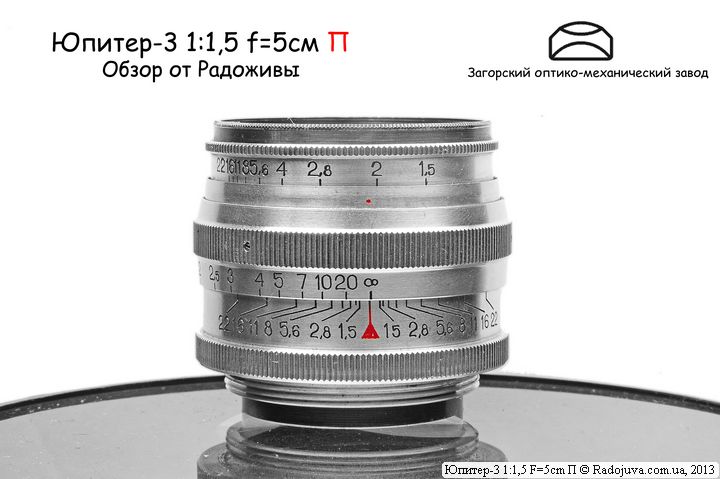
Overview of Jupiter-3 1: 1,5 F = 5cm P
There are many different modifications of Jupiter-3, since the lens itself was produced at several Soviet factories and has undergone a number of modifications. My copy number is N5704933, which means that the lens was released in 1957 already from 'our' Soviet optical glass. This review is very superficial, since, for some reason, I am not currently able to test Jupiter-3 with focusing at infinity. Jupiter-3 1: 1,5 F = 5cm P is lens from rangefinder cameras with M39 mounting thread.
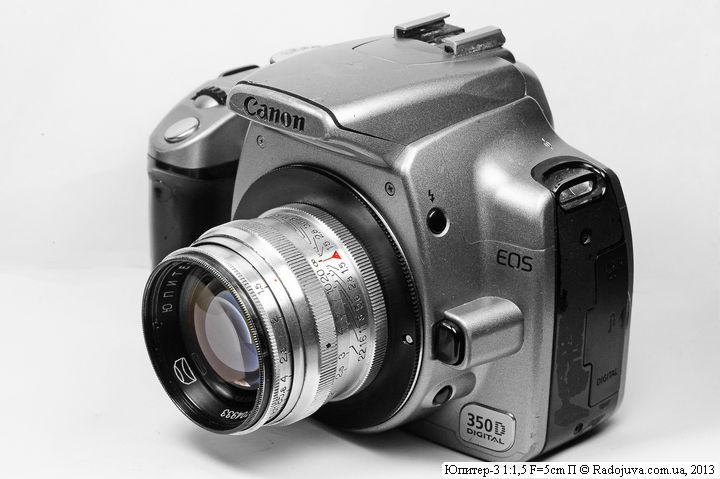
View of Jupiter-3 50 / 1.5 on the Central Control Commission
Now, in 2013, Jupiter-3 50 / 1.5 at flea markets sell at 150-200 cu It is considered one of the most legendary lenses of the Soviet Union, although it was originally copied from the German Zonnar. Soviet lenses with aperture F / 1.4, F / 1.5 can be counted on one hand. You can find an interesting overview of Jupiter-3 converted "to infinity" here.
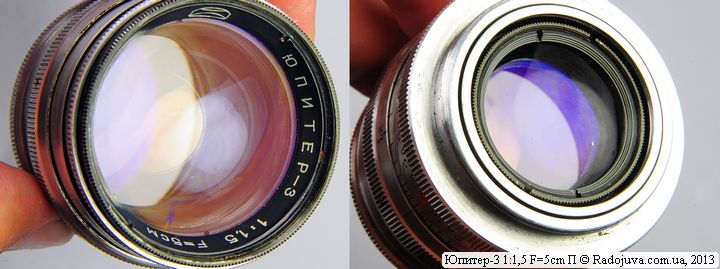
Type of enlightenment of the lens Jupiter-3 50 / 1.5
The lens has a single layer coating, which is indicated by the red letter 'P' in the lens name. The focusing ring rotates 180 degrees, the front lens does not rotate when focusing, and the lens trunk lengthens slightly. The MDF of the lens is 1 meter. Jupiter-3 50 / 1.5 is interesting for its 13 blade aperture. The aperture is continuously adjustable without fixed intermediate values. Very few lenses boast 13 diaphragm blades that form a perfect even hole, which creates the right circles of blur.
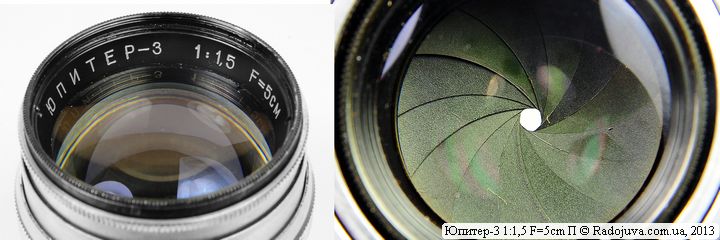
Jupiter-3 lens aperture
Sample Photos
Everything is shot at F / 1.5. The lens has a chic, unusual design. Many just love the bokeh of the lens. I used Jupiter-3 50 / 1.5 only in macro mode, because it is difficult for me to judge the quality of the photo in reality. But still, the lens gives a strong yellow-green tint in the photo and has pronounced spherical aberrations at F / 1.5.
My experience
On the Canon 350D I planted Jupiter-3 50 / 1.5 not using a conventional adapter, but simply drowned the lens in the bayonet shaft of the camera, and then fixed this design with an opaque adhesive tape. Thus, I tried to somewhat reduce the macro effect.
I do not recommend throwing away so much money for the sake of Jupiter-3 50 / 1.5, but the younger brother of the lens can serve as a quite worthy replacement for it - Jupiter 8... Jupiter-8 and Jupiter-3 take pride of place in my printed album of 'bockenators'. I was so delighted with the drawing of Jupiter-3 that I ordered a Jupiter-8 cinema lens for $ 3. for macro experiments :) although I have long sworn not to buy old manual optics!
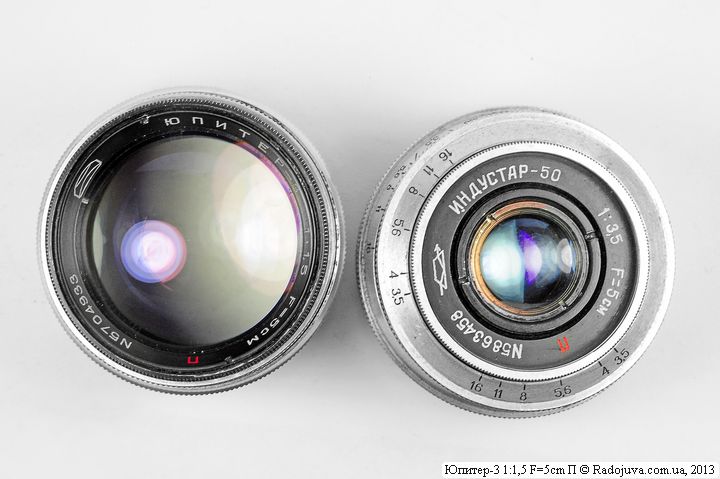
Sizes of two range-finding fifty dollars
How to use with modern cameras?
Lenses with an M39 thread (for rangefinder cameras, M39 X 1/28.8), such as the lens from this review, are very easy to use on almost any modern digital camera (both SLR and mirrorless), for this you just need to choose the right adapter (adapter). There is no need to carry out any additional actions to remake the lens. The cheapest adapters can be found at Aliexpress.com.
For mirrorless cameras
- SONY: For cameras with 'E'/'FE' mount series SonyNEX и Sony Alpha need here is an adapter M39 -Sony E (aka L39 -Sony Nex).
- OLYMPUS / PANASONIC / KODAK / XIAOMI: For cameras with a bayonet mount Micro 4/3 (Micro 4:3) need here is an adapter M39-Micro 4/3.
- CANON M: For cameras with Canon EF-M mount need here is such an adapter M39-Canon M.
- CANON R and RF-S: For cameras with Canon RF mount need here is such an adapter M39-Canon R.
- Nikon 1: For cameras Nikon 1 Series need here is such an adapter M39-Nikon 1.
- Nikon Z: For cameras Nikon Z series (FX/DX) needed here is such an adapter M39-Nikon Z.
- FUJIFILM X: For cameras with mount X need here is such an adapter M39-Fuji X.
- FUJIFILM GFX: For medium format cameras G-mount need here is such an adapter M39-Fuji GFX.
- SAMSUNG: NX mount cameras require here is an adapter M39-Samsung NX. There are no adapters for the NX mini camera yet.
- SIGMA / PANASONIC / LEICA: For cameras with L mount need here is such an adapter M39-Leica L.
- LEICA: For cameras with a bayonet mount Leica M need here is an adapter M39-L / M.
It's important: for SLR cameras, only macro mode is possible (can only shoot at very close focusing distances).
For SLR cameras (macro mode only)
- Canon: For cameras Canon EOS with bayonet mount EF / EF-S need here is an adapter M39 -Canon EOS.
- NIKON: For cameras Nikon DX / FXas well as for cameras Fujifilm и Kodak with Nikon F mount needed here is such an adapter M39 -Nikon F (some cameras will only work in M-mode).
- PENTAX: For Pentax K-mount cameras, you need here is such an adapter M39 -Pentax K.
- SONY/MINOLTA: For cameras with a Sony/Minolta A mount, you need here is an adapter M39 -Sony A.
- OLYMPUS/PANASONIC/LEICA: For cameras with 4/3 mount (not to be confused with Micro 4/3!) here is an adapter M39 -4/3.
Comments on this post do not require registration. Anyone can leave a comment. Many different photographic equipment can be found on AliExpress.
Conclusions:
Jupiter-3 1: 1,5 F = 5cm P - small, compact super-high-aperture Soviet fifty for rangefinder cameras. It has a very nice drawing, but unfortunately there is no mirror version of the lens. Nowadays Jupiter-3 50 / 1.5 is more expensive than many 'native' autofocus reflexes of fifty dollars.
You can still read interesting information on JUPITER-3 in the review JUPITER-3 1,5/50 with mount Contax-Kiev RF.
Material prepared Arkady Shapoval. Training/Consultations | Youtube | Facebook | Instagram | Twitter | Telegram

















While the photos are indoors, the streets will be later
Here, fluorescent lamps spoil the whole compote
Indoor without flash
I have a 1956 copy with a lot of micro-scratches on the front lens. Perhaps it is this that influences the fact that the lens does not hold at all not only backlight, but even side light. Nevertheless, I decided to keep the lens with myself, because, let's say ... "atmospheric" :-)
A couple of test shots taken immediately after purchase:
http://mihanev.ru/blog/-yupiter-3.html
As promised street photos
More
Panorama
Very sad, this lens is clearly not the right application.
And the culprit of the banquet itself
I looked at all these dances with a tambourine around the over-praised Jupiter 3, compared it with the 50/1,7 minolta pattern that I bought for 1,5 rubles in 2016 and realized that we didn’t need the Jupiter shore, my minolta was everything. plastic watercolors and airy not flaky bokeh and constructive forever.
Honestly, I don’t see anything really bad in Jupiter. If I approached it on the cost side, I got it for free. Therefore, it has the right to life. Each lens has fans and vice versa.
minolta for one and a half thousand ?? nafig is not necessary.
Jupiter 3 can be found for 200 rubles, yes an adapter will cost 300 rubles, a convenient iron construct without any ugly watercolors in the picture.
I was looking for Jupiter-3 for three years. On Hammer (while he was alive), on Avito, on au.ru, on eBay, on LensClub, on the Flea market ClubFoto.Ru. And therefore I can responsibly declare - you are wrong. It is impossible to find Jupiter-3 for 200 rubles
And here it is ... YES!
http://vk.com/lynx_tassi?w=wall16592987_16517%2Fall
And the lynx never looked for him. They just went in, saw and bought ...
Could of course be cut off with you for a dispute, but alas, I do not argue.
And I went broke yesterday, but for some reason ideally Krasnogorsk 1956 birth is handsome!
congratulating!
Where did you buy if not a server? :)
Antiques on Karl Marx. But there is no more.
Jupiter 3 for 1500 rubles? Aperture 1,5 for 1,5k? Give me two!!! I love fairy tales.
I think I like the glass
in the evening I tested
A ragged Jupiter-3 costs 4000-5000 tyrs today. new 7000-9000 tyrov ... What they write at the top is incomprehensible, apparently they did not get off the time machine ... And the drawing of Jupiter-2 and the depth of field deserves respect (if anyone has eyes) and understanding.
Sori: I wrote Jupitnr-2 sealed up ... And then they will drag ... the rabbits.
Tell me how to understand what year the lens? Is there any sort of base of serial numbers or a comparison of appearance? I dug up the Internet floor, but everywhere the same infa, supposedly remade in 54 on our glass, but how changed HZ.
Help, a friend asks for such a glass before alteration (with Zeiss glass) I do not want to swear!
Yes, no one used Zeiss glass in what was called Jupiter-3. Never.
They could change the enlightenment, the boring of the lenses, whatever - but not the types of glass and radii of curvature, thickness.
Look for the ZK 50 / 1.5 of the 40s with a Dove prism without a beam, there are still chances, for “Zonnar Krasnogorskiy” ... And then - there is really no information.
In 1950-51 the last batch of ZK-Jupiter - 3 was released. The release was small. The glasses were from Zeiss. In the latest version, ZK began to be renamed Jupiter - 3, when they decided to release their own line of lenses. So, the last Zonnars from Zeiss released in Krasnogorsk all the same already bore the name Jupiter - 3. They are very easy to distinguish by the "eared" diaphragm. (They were also made of lenses ready from Zeiss. On such copies of the ZK-Jupiter-3 there is a serial number of the lens unit on the tail of the line block.) And in appearance they differ, it can be seen that they were made at another plant. Conclusion: 1. Zeiss glasses were used. 2. Early ZK - Jupiter - 3, this is Carl Zeiss. And only then they counted the optics for our types of glass, and since 1954, Jupiters have been guaranteed to come with our native glasses.
There, there’s a serial on the tail of the lens-block and enlightenment of a pale sky color, I have 9 Jupiter, although it is pretty dragged by my life, but at the same time it gives a slightly better picture from those that are in the state of the new 57 and 61 years of release. But there’s no special purpose in hunting for such a thing, it’s very rare, and that difference in the picture is noticeable only when comparing head-on.
So so. First. “Zeiss” lenses can be distinguished: a) by the brass (not aluminum) frame of the lens unit itself; b) according to the collapsible design of this lens unit (rear lenses in a separate frame are screwed into a brass tube), and the rear frame must have a number. Please note that unlike the original zonnars, where the numbers on the nameplate and on the back frame must match (otherwise it is self-assembly), they often DO NOT coincide for Jupiters and ZK. The “eared” diaphragm was different: there are absolute copies of the zonnar along the notch (I don’t know if the details are German or copied exactly), but there are “ears” with a slightly larger notch (in the Yu-3, I did not see the ZK). Second. The quality of the vaunted early ZK and Yu-3 is very unstable - in the corners, I have. in mind. The sharpness of the later U-3s in the corners is much better, and I consider the Zagorsk U-3s of the 60s to be ideal. Third. Achilles' heel of U-3 is light scattering. The fact is that (practically no one knows about this) the zonnar had multi-layered enlightenment (yes, yes!). Anyone who has seen it will never confuse the original Zonnar with a fake. There were two layers - that's for sure, I saw it personally under a microscope on the scratched places, whether there was another layer - I don't know. Our team took out a vacuum chamber on an airplane to spray enlightenment, but they banged it when the plane crashed. After that, experiments with single-layer clarifications began. There were many options. The early U-3s, on the whole, quite successfully imitate the zonnars in terms of the highlight color, but the contrast is still worse, and the hares are stronger. The most disgusting enlightenment is bright turquoise, from which turquoise hares jump all over the frame, and the image turns very yellow (for reference: the tint of the image is always complementary to the enlightenment color), more precisely, even with a brownish tint. The most transparent (but slightly yellow to light) Ju-3 is amethyst in color (ZOMZ 1960s). The most color-neutral images are with amber coating (including Valdai). The fourth - again about light scattering: lens blackening. Papa Carlo's lens ends were ABSOLUTELY black. And coupled with the cartoonish enlightenment, it gives very good contrast in the shadows, no veil. Moreover, Zeiss Jena and Zeiss Oberkochen are exactly the same (well, it is true, I tested only two Oberkochen zonnars, so I cannot vouch for the mass character). But there is one byaka: this most remarkable blackening lags behind shells (not like Schneider's, with “schneiderite” bubbles, but shells). Therefore, if you saw a lens where the ends are half completely black and half completely unblacked, this is most likely a zonnar. As always, we have everything in between: the early U-3s (up to the 60s) have gray rather than black lens ends, but from the 70s the trouble begins, blackening becomes very bad, barely noticeable. It is clear that such lenses flare in order. Well, something like this…
another soviet nedocopia
... which is better than the original? (comparison in a lab somewhere on the lance was, clearly not in favor of Zonnar)
Artyom, did you personally compare them in order to dismissively about a “shovel copy”? I was comparing. By the will of fate, several dozen Jupiters, ZK and Zonnars passed through my hands. Mainly in Soviet times - they were not in short supply then. So, a short summary. The ZK and the early ("eared") Ju-3s are no better, and often worse than the Zonnars, which is not surprising - they were collected from Zeiss illiquid assets. From 1956-1957 the situation changed: Jupiters became BETTER in resolution than their prototype. By the way, if anything, even during the war, ours learned to produce glass without bubbles, which the Germans did not know how later. The sonnar has only one advantage: slightly higher contrast and definitely better glare resistance.
I have it with a M42 landing thread.
What do you need to
https://content27-foto.inbox.lv/albums/c/citro.m/Jupiter-3/RausstarMbw.jpg
Something from the archive
Such are the bikes)
Glass is interesting, sorry sold
..2015
Rumor has it that the new Zenitar - 1,5 / 50 with E-mount for Sony mirrorless cameras, scheduled for release in 2021, is our Jupiter-3 with a new frame. It may well be - the flange allows you to point to infinity.
https://radojuva.com/2020/12/zenit-zenitar-1-5-50-e-mount-full-frame/#comments
Great lens, the drawing is just magical. Today I also have a white frame in addition to the black version))
What sharpness is better for black or white?
Such lenses seem to preserve infinity on mirrorless cameras.
Adapter M39 - Nikon Z.
But the price of $ 100-150 for a 60-year-old lens is not entirely clear.
Yes, it's expensive. This is due to the relative rarity of the optical design and the uniqueness of its design. Well, the parameters are delicious. Again, if you look at the prices of old Japanese or German rangefinder lenses, there are generally crazy numbers. Although in essence...
I found such a Zagorsky 62 years old in a worn case, but with excellent condition of the lenses - no scratches, there is also a bubble inside! Having made a couple of test photos during the purchase, I immediately realized that I would take it away, I really liked the picture. Then I filmed everything for half a day, I even forgot to eat. Most of the pictures turned out, however, soap. But voluminous))
Question. The focus ring is tight. Is it worth it to give it for reassembly / relubrication, or is it better not to go inside, just use it?
This “grease” is already 60 years old, can you imagine what it has become? It can jam and not only the focuser. Of course it's better to re-grease. It’s better not to climb yourself if you don’t have experience.
Drop a couple of drops of WD-40 and wait, then gradually develop. DO NOT SPRAY! Just carefully drip.
"Great" advice. Nothing (!) can be dripped into the lens if disassembly is not planned. I saw such drippers who bring glass with the words “I tried to fix it”.
Only disassembly, flushing and new lubrication.
Friends, can someone explain in more detail about their enlightenment? I'm interested in warm tones, towards red, what shade of enlightenment should there be on the lens? I’m looking at the lens, I’ve already seen three variations of the Y3 coating: amethyst, swamp, sky-greenish... How can you understand? The question is precisely about the transmission of the spectrum, and not about tinting the glass with yellowness... But the glass material probably also matters? It's chaotic because I'm confused :). Thank you.
Look for lenses with purple coating or pink-violet. The glass itself in Yu3 is hardly yellow, we are talking about the coating effect.
Thanks a lot. Am I understanding correctly, something like this? serial number 6207166.
With this, the picture will be warm, but you will catch a thick blue veil, which is difficult to get rid of. Not an easy option to use.
Or like this?
I think this one will be more predictable in use.